MGT1OBE: Analyzing Motivational Theories in the Workplace Essay
VerifiedAdded on 2023/01/18
|7
|1379
|65
Essay
AI Summary
This essay critically analyzes content and process theories of work motivation, focusing on Maslow's hierarchy of needs (content) and equity theory (process). It compares and contrasts these theories, highlighting their similarities and differences in influencing employee behavior. The paper illustrates their usefulness for managers within a real-life organization, emphasizing how these theories can boost employee satisfaction, engagement, and overall organizational success. The essay uses Wesfarmers as a case study, demonstrating how the application of these motivational theories can lead to improved performance and goal attainment in a competitive market. The conclusion reinforces the importance of integrating both content and process theories to enhance workplace dynamics and productivity.
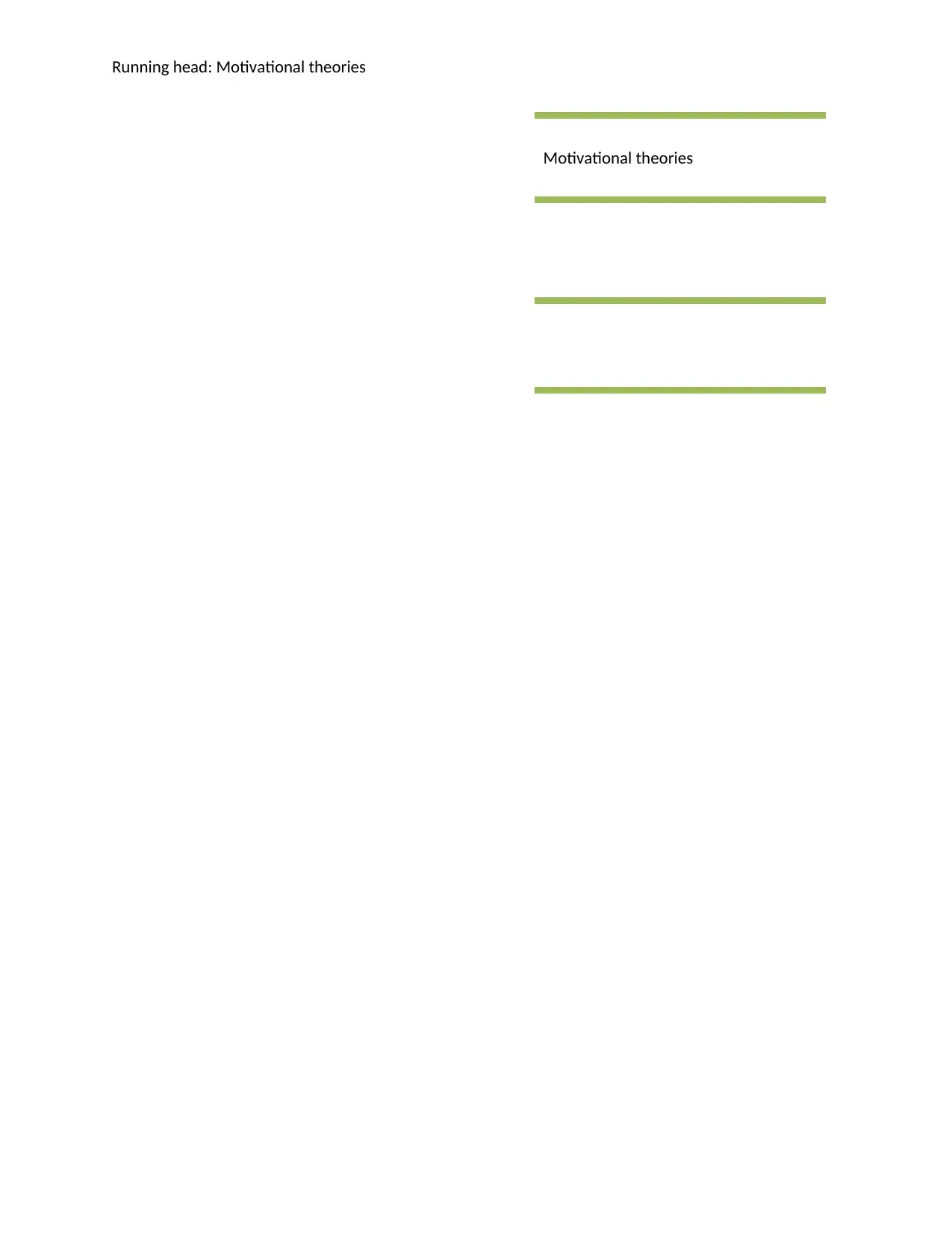
Running head: Motivational theories
Motivational theories
Motivational theories
Paraphrase This Document
Need a fresh take? Get an instant paraphrase of this document with our AI Paraphraser
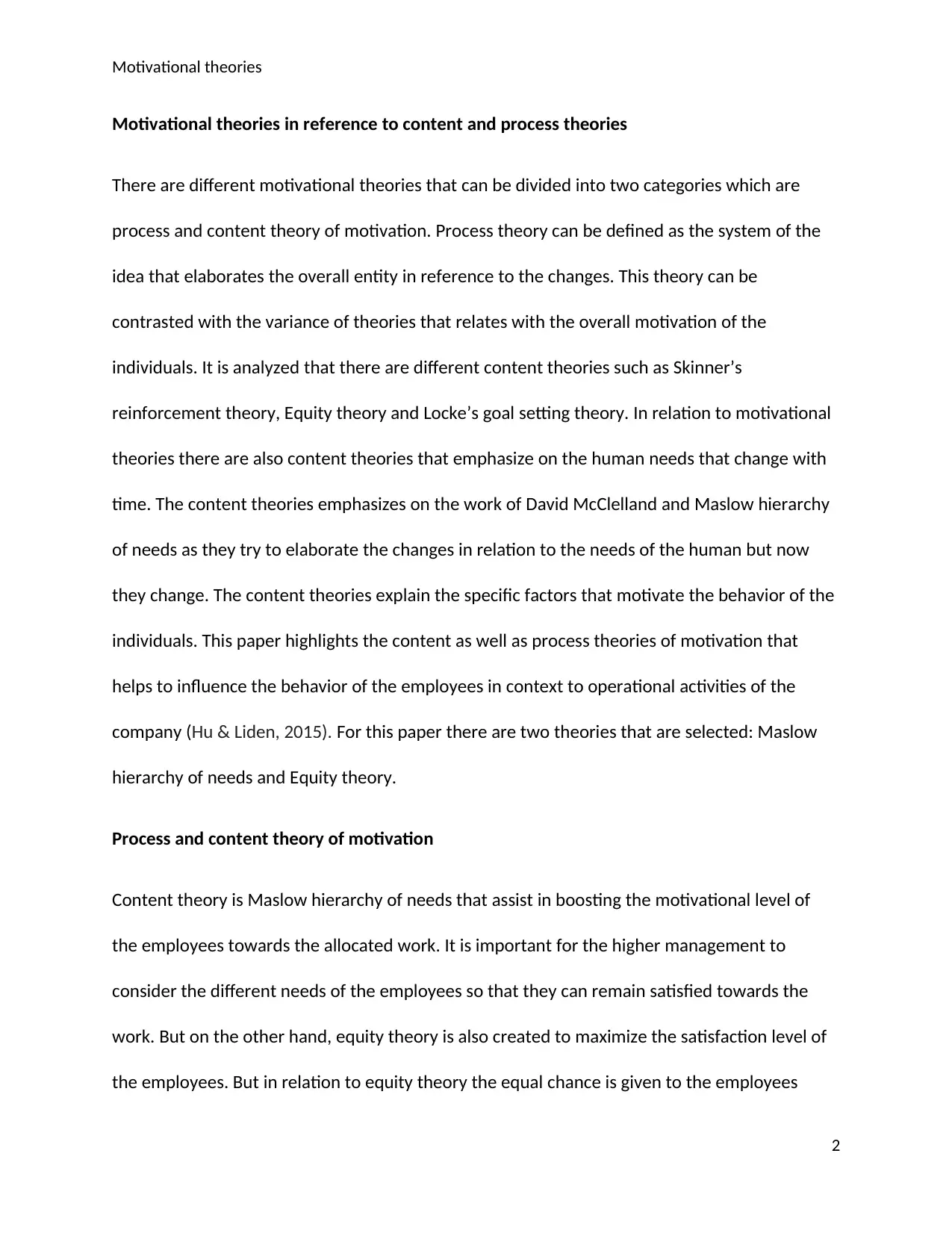
Motivational theories
Motivational theories in reference to content and process theories
There are different motivational theories that can be divided into two categories which are
process and content theory of motivation. Process theory can be defined as the system of the
idea that elaborates the overall entity in reference to the changes. This theory can be
contrasted with the variance of theories that relates with the overall motivation of the
individuals. It is analyzed that there are different content theories such as Skinner’s
reinforcement theory, Equity theory and Locke’s goal setting theory. In relation to motivational
theories there are also content theories that emphasize on the human needs that change with
time. The content theories emphasizes on the work of David McClelland and Maslow hierarchy
of needs as they try to elaborate the changes in relation to the needs of the human but now
they change. The content theories explain the specific factors that motivate the behavior of the
individuals. This paper highlights the content as well as process theories of motivation that
helps to influence the behavior of the employees in context to operational activities of the
company (Hu & Liden, 2015). For this paper there are two theories that are selected: Maslow
hierarchy of needs and Equity theory.
Process and content theory of motivation
Content theory is Maslow hierarchy of needs that assist in boosting the motivational level of
the employees towards the allocated work. It is important for the higher management to
consider the different needs of the employees so that they can remain satisfied towards the
work. But on the other hand, equity theory is also created to maximize the satisfaction level of
the employees. But in relation to equity theory the equal chance is given to the employees
2
Motivational theories in reference to content and process theories
There are different motivational theories that can be divided into two categories which are
process and content theory of motivation. Process theory can be defined as the system of the
idea that elaborates the overall entity in reference to the changes. This theory can be
contrasted with the variance of theories that relates with the overall motivation of the
individuals. It is analyzed that there are different content theories such as Skinner’s
reinforcement theory, Equity theory and Locke’s goal setting theory. In relation to motivational
theories there are also content theories that emphasize on the human needs that change with
time. The content theories emphasizes on the work of David McClelland and Maslow hierarchy
of needs as they try to elaborate the changes in relation to the needs of the human but now
they change. The content theories explain the specific factors that motivate the behavior of the
individuals. This paper highlights the content as well as process theories of motivation that
helps to influence the behavior of the employees in context to operational activities of the
company (Hu & Liden, 2015). For this paper there are two theories that are selected: Maslow
hierarchy of needs and Equity theory.
Process and content theory of motivation
Content theory is Maslow hierarchy of needs that assist in boosting the motivational level of
the employees towards the allocated work. It is important for the higher management to
consider the different needs of the employees so that they can remain satisfied towards the
work. But on the other hand, equity theory is also created to maximize the satisfaction level of
the employees. But in relation to equity theory the equal chance is given to the employees
2
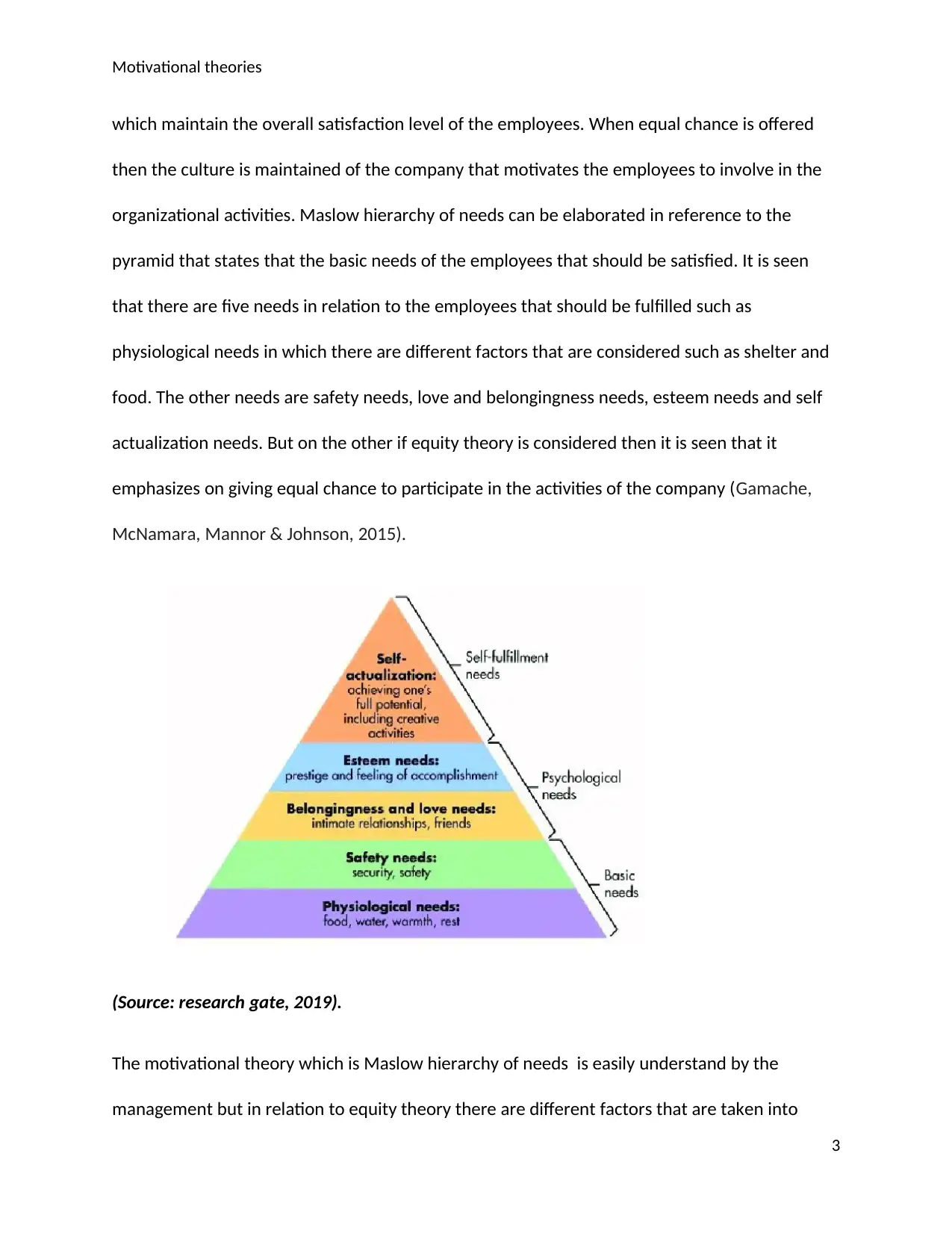
Motivational theories
which maintain the overall satisfaction level of the employees. When equal chance is offered
then the culture is maintained of the company that motivates the employees to involve in the
organizational activities. Maslow hierarchy of needs can be elaborated in reference to the
pyramid that states that the basic needs of the employees that should be satisfied. It is seen
that there are five needs in relation to the employees that should be fulfilled such as
physiological needs in which there are different factors that are considered such as shelter and
food. The other needs are safety needs, love and belongingness needs, esteem needs and self
actualization needs. But on the other if equity theory is considered then it is seen that it
emphasizes on giving equal chance to participate in the activities of the company (Gamache,
McNamara, Mannor & Johnson, 2015).
(Source: research gate, 2019).
The motivational theory which is Maslow hierarchy of needs is easily understand by the
management but in relation to equity theory there are different factors that are taken into
3
which maintain the overall satisfaction level of the employees. When equal chance is offered
then the culture is maintained of the company that motivates the employees to involve in the
organizational activities. Maslow hierarchy of needs can be elaborated in reference to the
pyramid that states that the basic needs of the employees that should be satisfied. It is seen
that there are five needs in relation to the employees that should be fulfilled such as
physiological needs in which there are different factors that are considered such as shelter and
food. The other needs are safety needs, love and belongingness needs, esteem needs and self
actualization needs. But on the other if equity theory is considered then it is seen that it
emphasizes on giving equal chance to participate in the activities of the company (Gamache,
McNamara, Mannor & Johnson, 2015).
(Source: research gate, 2019).
The motivational theory which is Maslow hierarchy of needs is easily understand by the
management but in relation to equity theory there are different factors that are taken into
3
⊘ This is a preview!⊘
Do you want full access?
Subscribe today to unlock all pages.

Trusted by 1+ million students worldwide
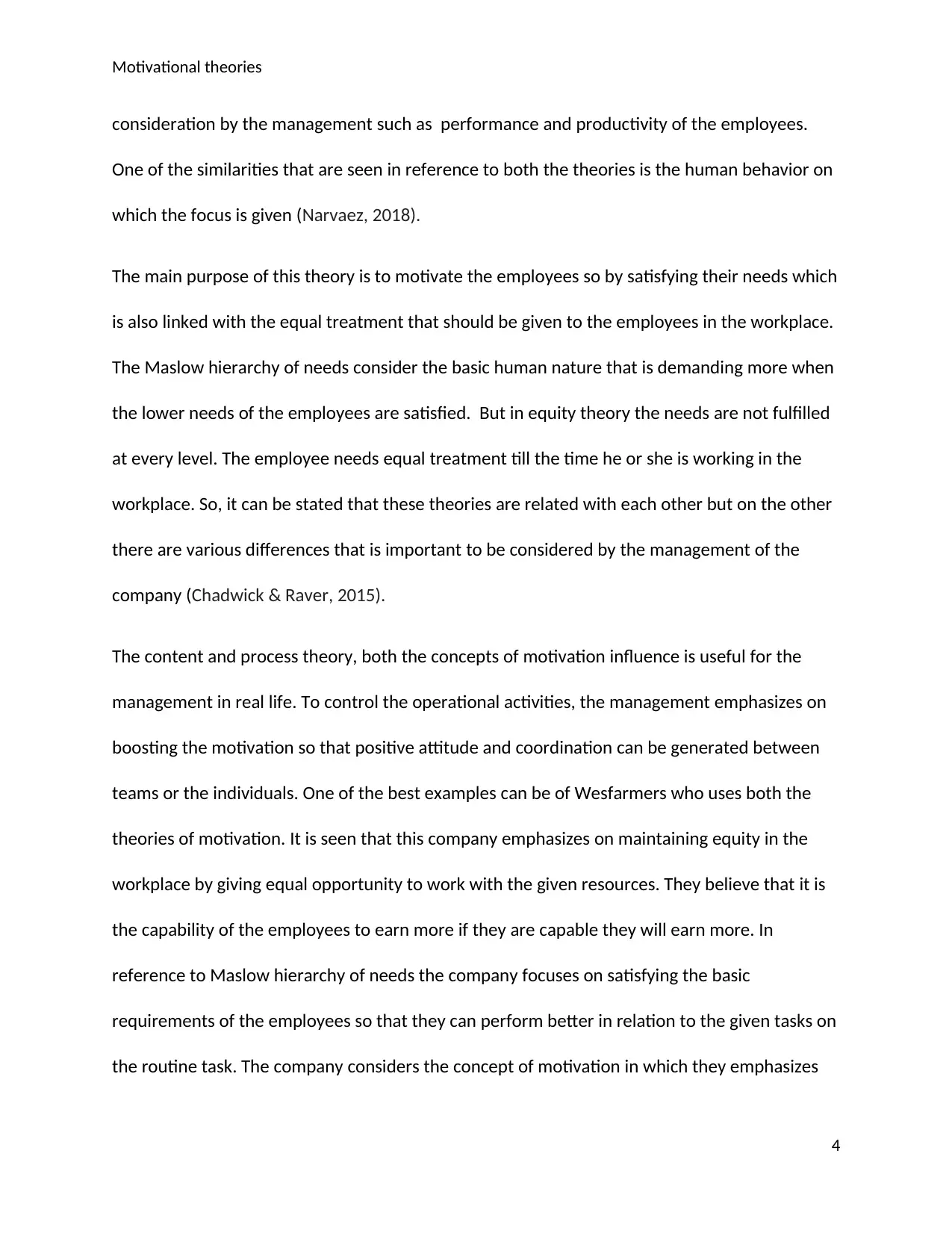
Motivational theories
consideration by the management such as performance and productivity of the employees.
One of the similarities that are seen in reference to both the theories is the human behavior on
which the focus is given (Narvaez, 2018).
The main purpose of this theory is to motivate the employees so by satisfying their needs which
is also linked with the equal treatment that should be given to the employees in the workplace.
The Maslow hierarchy of needs consider the basic human nature that is demanding more when
the lower needs of the employees are satisfied. But in equity theory the needs are not fulfilled
at every level. The employee needs equal treatment till the time he or she is working in the
workplace. So, it can be stated that these theories are related with each other but on the other
there are various differences that is important to be considered by the management of the
company (Chadwick & Raver, 2015).
The content and process theory, both the concepts of motivation influence is useful for the
management in real life. To control the operational activities, the management emphasizes on
boosting the motivation so that positive attitude and coordination can be generated between
teams or the individuals. One of the best examples can be of Wesfarmers who uses both the
theories of motivation. It is seen that this company emphasizes on maintaining equity in the
workplace by giving equal opportunity to work with the given resources. They believe that it is
the capability of the employees to earn more if they are capable they will earn more. In
reference to Maslow hierarchy of needs the company focuses on satisfying the basic
requirements of the employees so that they can perform better in relation to the given tasks on
the routine task. The company considers the concept of motivation in which they emphasizes
4
consideration by the management such as performance and productivity of the employees.
One of the similarities that are seen in reference to both the theories is the human behavior on
which the focus is given (Narvaez, 2018).
The main purpose of this theory is to motivate the employees so by satisfying their needs which
is also linked with the equal treatment that should be given to the employees in the workplace.
The Maslow hierarchy of needs consider the basic human nature that is demanding more when
the lower needs of the employees are satisfied. But in equity theory the needs are not fulfilled
at every level. The employee needs equal treatment till the time he or she is working in the
workplace. So, it can be stated that these theories are related with each other but on the other
there are various differences that is important to be considered by the management of the
company (Chadwick & Raver, 2015).
The content and process theory, both the concepts of motivation influence is useful for the
management in real life. To control the operational activities, the management emphasizes on
boosting the motivation so that positive attitude and coordination can be generated between
teams or the individuals. One of the best examples can be of Wesfarmers who uses both the
theories of motivation. It is seen that this company emphasizes on maintaining equity in the
workplace by giving equal opportunity to work with the given resources. They believe that it is
the capability of the employees to earn more if they are capable they will earn more. In
reference to Maslow hierarchy of needs the company focuses on satisfying the basic
requirements of the employees so that they can perform better in relation to the given tasks on
the routine task. The company considers the concept of motivation in which they emphasizes
4
Paraphrase This Document
Need a fresh take? Get an instant paraphrase of this document with our AI Paraphraser
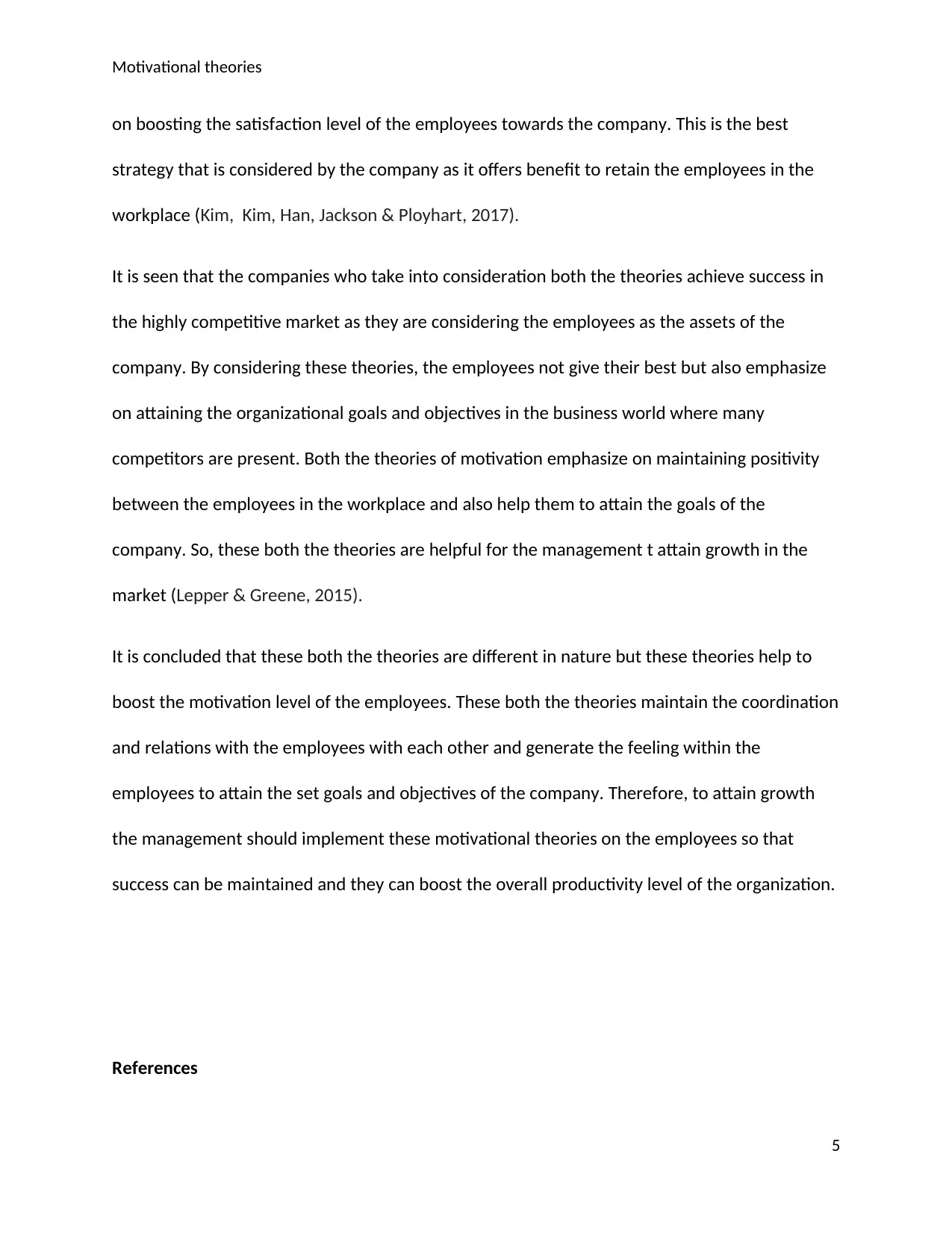
Motivational theories
on boosting the satisfaction level of the employees towards the company. This is the best
strategy that is considered by the company as it offers benefit to retain the employees in the
workplace (Kim, Kim, Han, Jackson & Ployhart, 2017).
It is seen that the companies who take into consideration both the theories achieve success in
the highly competitive market as they are considering the employees as the assets of the
company. By considering these theories, the employees not give their best but also emphasize
on attaining the organizational goals and objectives in the business world where many
competitors are present. Both the theories of motivation emphasize on maintaining positivity
between the employees in the workplace and also help them to attain the goals of the
company. So, these both the theories are helpful for the management t attain growth in the
market (Lepper & Greene, 2015).
It is concluded that these both the theories are different in nature but these theories help to
boost the motivation level of the employees. These both the theories maintain the coordination
and relations with the employees with each other and generate the feeling within the
employees to attain the set goals and objectives of the company. Therefore, to attain growth
the management should implement these motivational theories on the employees so that
success can be maintained and they can boost the overall productivity level of the organization.
References
5
on boosting the satisfaction level of the employees towards the company. This is the best
strategy that is considered by the company as it offers benefit to retain the employees in the
workplace (Kim, Kim, Han, Jackson & Ployhart, 2017).
It is seen that the companies who take into consideration both the theories achieve success in
the highly competitive market as they are considering the employees as the assets of the
company. By considering these theories, the employees not give their best but also emphasize
on attaining the organizational goals and objectives in the business world where many
competitors are present. Both the theories of motivation emphasize on maintaining positivity
between the employees in the workplace and also help them to attain the goals of the
company. So, these both the theories are helpful for the management t attain growth in the
market (Lepper & Greene, 2015).
It is concluded that these both the theories are different in nature but these theories help to
boost the motivation level of the employees. These both the theories maintain the coordination
and relations with the employees with each other and generate the feeling within the
employees to attain the set goals and objectives of the company. Therefore, to attain growth
the management should implement these motivational theories on the employees so that
success can be maintained and they can boost the overall productivity level of the organization.
References
5
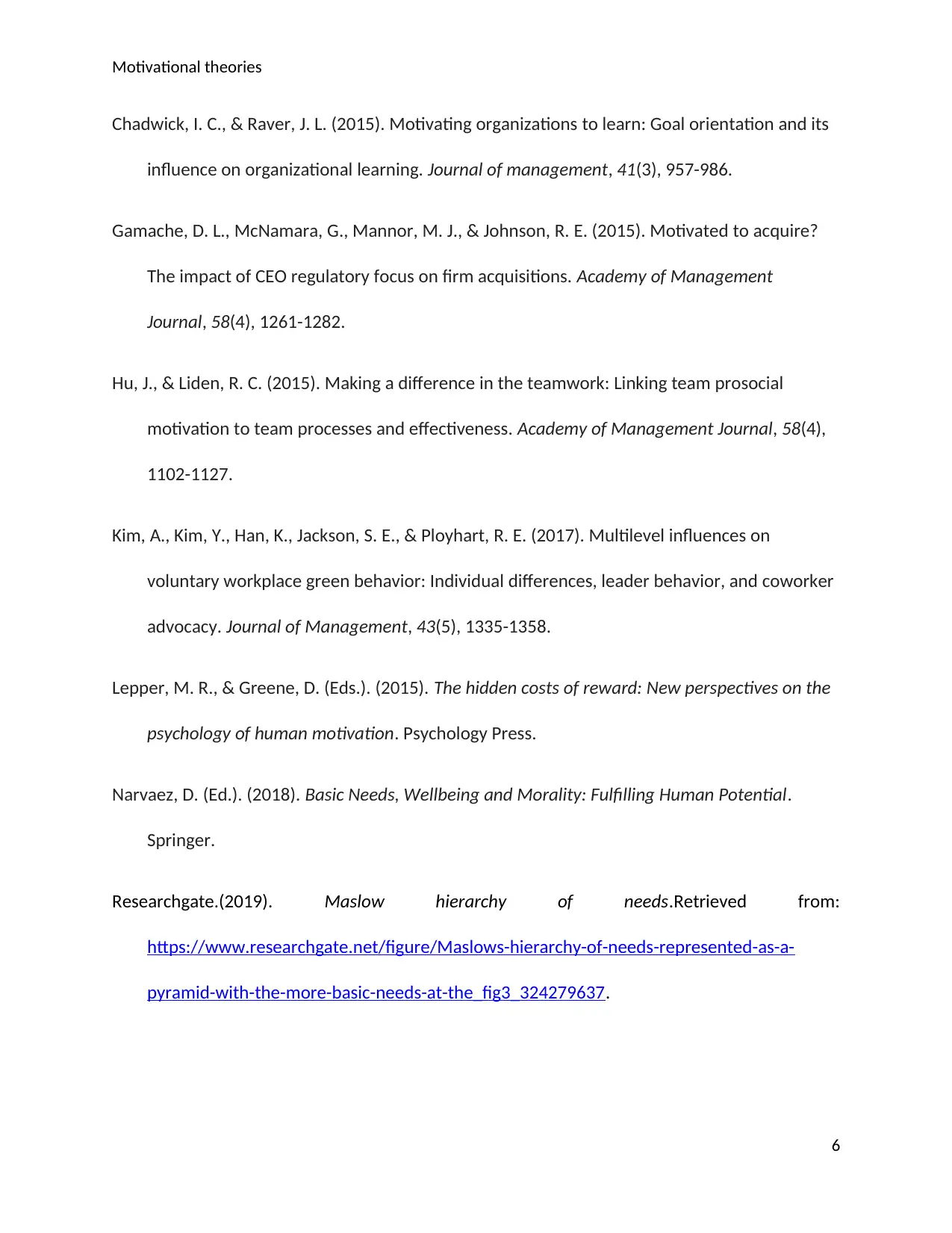
Motivational theories
Chadwick, I. C., & Raver, J. L. (2015). Motivating organizations to learn: Goal orientation and its
influence on organizational learning. Journal of management, 41(3), 957-986.
Gamache, D. L., McNamara, G., Mannor, M. J., & Johnson, R. E. (2015). Motivated to acquire?
The impact of CEO regulatory focus on firm acquisitions. Academy of Management
Journal, 58(4), 1261-1282.
Hu, J., & Liden, R. C. (2015). Making a difference in the teamwork: Linking team prosocial
motivation to team processes and effectiveness. Academy of Management Journal, 58(4),
1102-1127.
Kim, A., Kim, Y., Han, K., Jackson, S. E., & Ployhart, R. E. (2017). Multilevel influences on
voluntary workplace green behavior: Individual differences, leader behavior, and coworker
advocacy. Journal of Management, 43(5), 1335-1358.
Lepper, M. R., & Greene, D. (Eds.). (2015). The hidden costs of reward: New perspectives on the
psychology of human motivation. Psychology Press.
Narvaez, D. (Ed.). (2018). Basic Needs, Wellbeing and Morality: Fulfilling Human Potential.
Springer.
Researchgate.(2019). Maslow hierarchy of needs.Retrieved from:
https://www.researchgate.net/figure/Maslows-hierarchy-of-needs-represented-as-a-
pyramid-with-the-more-basic-needs-at-the_fig3_324279637.
6
Chadwick, I. C., & Raver, J. L. (2015). Motivating organizations to learn: Goal orientation and its
influence on organizational learning. Journal of management, 41(3), 957-986.
Gamache, D. L., McNamara, G., Mannor, M. J., & Johnson, R. E. (2015). Motivated to acquire?
The impact of CEO regulatory focus on firm acquisitions. Academy of Management
Journal, 58(4), 1261-1282.
Hu, J., & Liden, R. C. (2015). Making a difference in the teamwork: Linking team prosocial
motivation to team processes and effectiveness. Academy of Management Journal, 58(4),
1102-1127.
Kim, A., Kim, Y., Han, K., Jackson, S. E., & Ployhart, R. E. (2017). Multilevel influences on
voluntary workplace green behavior: Individual differences, leader behavior, and coworker
advocacy. Journal of Management, 43(5), 1335-1358.
Lepper, M. R., & Greene, D. (Eds.). (2015). The hidden costs of reward: New perspectives on the
psychology of human motivation. Psychology Press.
Narvaez, D. (Ed.). (2018). Basic Needs, Wellbeing and Morality: Fulfilling Human Potential.
Springer.
Researchgate.(2019). Maslow hierarchy of needs.Retrieved from:
https://www.researchgate.net/figure/Maslows-hierarchy-of-needs-represented-as-a-
pyramid-with-the-more-basic-needs-at-the_fig3_324279637.
6
⊘ This is a preview!⊘
Do you want full access?
Subscribe today to unlock all pages.

Trusted by 1+ million students worldwide

Motivational theories
7
7
1 out of 7
Related Documents
Your All-in-One AI-Powered Toolkit for Academic Success.
+13062052269
info@desklib.com
Available 24*7 on WhatsApp / Email
![[object Object]](/_next/static/media/star-bottom.7253800d.svg)
Unlock your academic potential
Copyright © 2020–2025 A2Z Services. All Rights Reserved. Developed and managed by ZUCOL.





